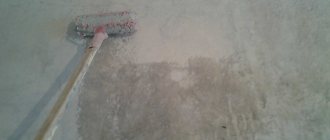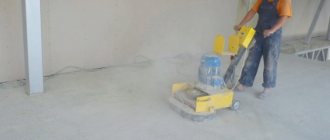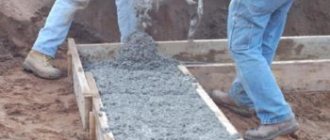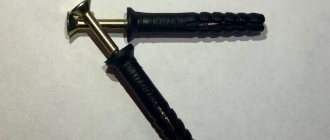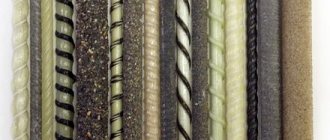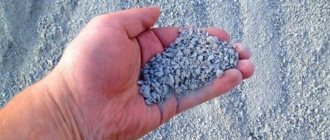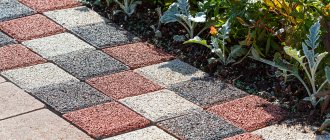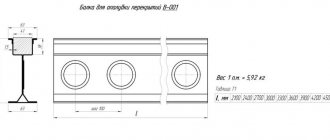This is a material used for preliminary surface preparation before applying any coating.
To put it more commonly, it’s a primer. The purpose of priming (treating the surface with a primer
) is to strengthen porous and weak substrates, prevent dust formation, and also ensure reliable adhesion with the polymer coating on any building surfaces.
The process of preparing the base for the application of polymer coatings consists of grinding (to remove surface contaminants), removing dust and filling chips and holes. At the same time, weakly fixed particles and fine dust appear on the surface, clogged in the pores of the surface. It is impossible to remove such particles mechanically, and the particles themselves prevent good adhesion to the surface.
You should always remember that the key to success can only be mandatory, high-quality preparation of the foundation. Therefore, primers
play a very important role in construction. In each specific case, you should seek instructions and clarification from manufacturers and suppliers of paints and varnishes.
According to the base material primers
This is what they call: polyurethane
primer
, epoxy
primer
, bitumen
primer
, etc.
Bitumen primer is
a material that is made from organic solvents and high-quality bitumens, due to which it has high heat resistance and penetrating ability, which means that the bitumen
primer
is absorbed deeply into the structure of the surface being treated and provides a long-term effect.
Bitumen primer
is characterized by a short drying time and an absolute lack of stickiness, which makes it an almost irreplaceable and convenient material for gluing waterproofing.
It is applied for
primers for concrete slabs, cement-sand screed, etc. before laying built-up and self-adhesive roofing and waterproofing materials. Provides high-quality adhesion of waterproofing materials to porous, rough and dusty surfaces using a deep penetrating, quick-drying agent.
There are several types of bitumen primers
, having a clearly defined purpose:
- roofing primer
is intended for surface correction before laying/fusing roofing materials on porous or rough substrates.
Roofing primer
can be used as an adhesive for various roll and sheet waterproofing materials. - road is used as a binder for crushed stone during the construction/repair of road surfaces.
- primer
for insulating coatings of pipelines is intended to increase adhesion to the covering material and as an anti-corrosion composition.
universal bitumen primer
used for insulating any surfaces that do not require the use of a specialized composition.
Primer application method
Before applying primer
it is necessary to carefully prepare the base - eliminate defects, clean from foreign particles that may prevent the layers from sticking together, and dry.
After preparing the base, the primer is, if necessary, diluted with a solvent (white spirit, gasoline, kerosene, nefras) and mixed thoroughly. Direct application to the surface can be carried out in different ways - using a brush, rubber mop, nylon brush, roller or by spraying.
When applying primer
Safety precautions must be strictly observed as it contains flammable components. In this regard, working with the material is only possible away from open flames (including smoking is prohibited), and the application specialist must work in protective glasses and gloves. In addition, the construction site must be equipped with fire extinguishing equipment.
Recommendations
.
Primer
treatment should be carried out only in dry weather at a temperature of minus 20 ° C. In addition, during the day the primed base should be protected from rain or moisture ingress in any other way. If processing is carried out inside a building, the room must be thoroughly ventilated.
Primer benefits
- Has good elasticity.
- Protects the surface from excess water absorption.
- Can be used over a wide temperature range (from –50°C to +120°C).
- Dries quickly.
- Easy to use.
- Easily penetrates into the impregnated surface.
It is important to know
1. Coating quality
80% depends on the quality of the preparation of the base, so you should always use
a primer
, even on fairly good quality bases.
2. The primer allows you to reduce
the absorption of water into the base, which allows you to apply the mixture in a thinner layer, which leads to saving material, and therefore money.
A major role in the further operation of any structure is played by the correct choice and high-quality production of such an element as the foundation. But making the foundation of the house well is half the battle. The main task is to properly protect it from adverse environmental factors. A special liquid, a foundation waterproofing primer, helps to cope with this task, among other things.
Types of waterproofing
The main material for the manufacture of many types of foundations is a concrete mixture, often reinforced with an additional steel reinforced frame. With all its positive properties, the sand-cement mixture with crushed stone has one significant drawback - low resistance to moisture. In this regard, for long-term operation of concrete products, they must be isolated from water, both atmospheric and ground.
In the last century, the main option for waterproofing a finished foundation was bitumen. It is obtained artificially as a product of refining oil, coal and other hydrocarbons, and is also mined in its natural form. To use bitumen as a coating waterproofing material, it had to be heated to a liquid state and used exclusively hot.
Bitumen as a coating waterproofing
Later, given the good solubility of the substance in organic solvents, they began to use ready-made waterproofing materials with a liquid consistency, which were called mastics. Unlike natural or synthesized bitumen in its pure form, waterproofing the foundation using these compounds sometimes did not require heating, which reduced the risk of burns when working with them.
Currently, the following types of mastics are used as coating waterproofing:
- Bitumen – is a solution of bitumen in solvents with various additives. Used cold.
- Bitumen-rubber is made on the basis of bitumen with the addition of crumb rubber and plasticizer. To bring the mastic into working condition, it must be heated.
- Bitumen-polymer mastic contains both classic bitumen and various artificial substances that improve the properties of the composition.
- Polymer mastic does not contain bitumen in its composition.
Preparing for foundation waterproofing
To prepare for waterproofing the foundation, it is recommended to further treat its surface. The best way to improve the adhesion of mastic to a concrete base is a liquid solution of bitumen in organic solvents, called a primer.
Views by component
Mastics for preparing and leveling the base before laying rolled waterproofing materials are produced with different compositions. The method of application, primer consumption, coverage, penetration and drying time depend on the composition. The following types of priming compositions are distinguished:
- Bitumen primer . This is a ready-to-use material that contains organic solvents and bitumen. If you purchased a concentrate, the primer will need to be diluted before use, and the composition must also be thoroughly mixed before using the material. It is suitable for all types of fused roofing and can be used even at sub-zero temperatures.
- Emulsion primer . The emulsion mastic is packaged in 20 liter metal Euro-buckets and is completely ready for application. This type of primer has high wetting ability, does not contain solvents, and does not emit flammable substances when drying, so it can be used near open fire sources.
- Bitumen-polymer primer . In addition to bitumen, the bitumen-polymer primer contains a solution of petroleum derivatives and stabilizers. It applies well to all materials, so it is suitable for all types of substrates, dries very quickly, and protects against corrosion.
Important! For DIY application, it is recommended to use bitumen-polymer mixtures that do not contain organic solvents. The covering qualities of bitumen-polymer primers are quite high, they are characterized by high coverage density, while their consumption is economical.
Bitumen primer for foundations
The bitumen primer for foundation waterproofing is quite liquid, which allows it to be applied in various ways, both manually and mechanically. Its effect is comparable to that of a classic construction primer, which is used to treat walls before pasting wallpaper and other roll materials. Primer treatment of the foundation should be carried out to the entire depth of its installation.
Apply the foundation primer using a classic paint brush with hard bristles. To increase processing speed, it is better to use the widest flute possible. You can also increase the processing speed by using a paint roller with a fur coat, which is held in your hand or mounted on a long wooden handle.
Applying foundation primer with a brush
Instead of traditional painting tools, primer can be applied to the foundation using a regular floor brush. The viscosity of the composition allows the use of such a non-standard “brush” on a long handle. This is especially convenient when processing the upper part of the foundation, as well as when working with the above-ground part of the base of the building.
Recommendations for use in roof repairs and installations
Bitumen primer with an organic solvent easily wets the surfaces of metal, concrete, brick and many mineral materials, contains additives of surfactants and a corrosion inhibitor. Penetrates into pores and surface cracks, wets and binds foreign particles and dust present on the surface.
Used to increase the adhesion of the base to the materials being deposited. Can be used for temporary waterproofing of building structures and protecting them from corrosion.
Application
Apply by roller, brush, air or airless spray to a dry surface free of dust, dirt and foreign objects.
It is advisable to apply the primer in two layers of no more than 0.5 mm each.
Consumption rate
Primer consumption per layer is ~0.25 l/m², depending on the structure and hygroscopicity of the base. For two-layer application:
- 20l per 40 m²
- 50l per 100 m²
Precautionary measures
- Carry out work with rubber gloves.
- It is prohibited to use open flames.
- When working indoors, ensure good ventilation.
- Flammable.
We prime the foundation with primer correctly
Before applying coating waterproofing or gluing roll materials, it is necessary to perform a number of preparatory operations and apply a bitumen foundation primer to the entire area of the base. The general scheme of work is as follows:
- First of all, it is necessary to ensure an approach to the work site. To do this, the soil is removed from the foundation at a distance of at least a meter.
- Next, the concrete base must be allowed to dry completely. This is especially true if the foundation was not covered with waterproofing materials in a timely manner.
- The next stage is cleaning the foundation surface from loose concrete particles, soil residues and other debris. For this purpose, various brushes with both metal and synthetic bristles are used.
- After all the preparatory work has been completed, the foundation is directly waterproofed with a primer. To do this, the composition is applied in the manner indicated above, trying to cover the entire surface of the base of the house or bathhouse without gaps. Many of today's bituminous primers have a very short drying time. This allows you to apply three or four layers of primer during daylight hours, with each layer completely drying.
- After the last layer has completely dried, which is checked by touching it for tack, you can apply the previously selected type of foundation waterproofing.
Primer application
Consumption and application
produces several types of primers, the articles of which are separated by serial numbers. Of the variety presented, No. 1 is considered a universal composition used in various fields of construction. In general, this is roofing bitumen, which is used for waterproofing structures for any purpose.
- Floor slabs.
- Foundation wall blocks.
- Screeds made of cement-sand mortar.
We invite you to familiarize yourself with: Neon paint for walls: instructions for applying it yourself, video and photos.
In addition, the primer can be used to treat plastered surfaces and wooden structures.
Whatever type of this primer you plan to purchase, you need to keep in mind that any type of bitumen primer has a certificate and a number of other documents required by law.
Don’t be shy about asking the sellers for them; besides, every reliable manufacturer and network that sells materials themselves makes sure that the buyer is always provided with all the necessary information.
As for direct use, this composition can be applied literally in any convenient way:
- brushes;
- brushes;
- rollers;
- sprayers and so on.
There are also no specific requirements for surface preparation; there are basic and self-evident ones - the surface must be dry and clean.
You need to pay attention to the requirements for drying the primer - the layer should be kept for 24 hours, at a temperature below 5 degrees. In fact, under these conditions, bitumen will dry out in 15-25 minutes, but the daily interval should be observed, as this is provided for by the manufacturer’s recommendations. Also, before use, the bucket of bitumen should be kept in a warm room.
From an economic point of view, the material is extremely profitable; on average, the consumption of bitumen primer per 1 m2 ranges from 0.200 to 0.350 liters. No other primer can boast such a low consumption level.
Emulsion, solvent-free, bitumen primer material has temperature restrictions associated with the exclusion of organic matter from its composition. You can work with this substance from 5 to 30 degrees.
What can be treated with bitumen primer
Bitumen primer can be applied to the following surfaces and structures:
- Flat roofing coverings.
- Bridge spans.
- External parts of metal pipelines.
- Floor slabs and coverings.
- Concrete structures: foundations, plinth and other building elements touching the soil.
- Walls and floors of basements and semi-basements.
Impregnation can be used not only on concrete surfaces. It can be applied to asbestos-cement, reinforced concrete, metal and wooden structures. Since impregnation resists corrosion and biological attack, it protects pipes from rotting, extending their service life.
Please note: in most cases, bitumen primers for roofing, foundations and other structures are no different. These are universal impregnations that are suitable for any materials, but there are also special formulations.
Gluing roll materials onto a primer
Characteristics
| Dry mix | |
| Filler fraction, mm, no more | 0,63 |
| Consumption per 1 m² when applying a layer 1 mm thick, kg | 1,5 |
| Approximate consumption per 1 linear meter of reinforcement with a diameter of 12 mm, kg | 0,1 |
| Approximate consumption per 1 linear meter of reinforcement with a diameter of 16 mm, kg | 0,2 |
| Mortar mixture | |
| Water consumption for mixing 1 kg of dry mixture, protection of fittings, l | 0,24-0,25 |
| Water consumption for mixing 1 kg of dry mixture, priming of dense concrete, l | 0,24-0,25 |
| Water consumption for mixing 1 kg of dry mixture, priming of porous surfaces, l | 0,5-0,6 |
| Viability, min | 30 |
| Water holding capacity, %, not less | 98 |
| Minimum application thickness, mm | 1,0 |
| Recommended application thickness, mm | 2,0 |
| Application temperature, ᵒC | from +5 to +35 |
| After curing | |
| Frost resistance grade, no less | F300 |
| Strength of adhesion to metal, MPa, not less | 3,0 |
| Strength of adhesion to concrete at the age of 7 days, MPa, not less | 1,2 |
| Adhesion strength to concrete at the age of 28 days, MPa, not less | 2,0 |
| Heat resistance under constant exposure, °C | +120 |
| Contact with drinking water | allowed |
| Operation in aggressive environments | 5< pH <14 |
| Climatic zones of application | All |
Basic Concepts
Bitumen mastic is a multicomponent composition based on petroleum construction bitumen, rubber crumbs, talc, chalk or asbestos, a number of plasticizers, coumaron resin and other additives. Some varieties include antiseptics and herbicides. The result is a homogeneous binder mass in liquefied or solid form, which is used to seal surfaces.
Bitumen primer is also a multicomponent composition based on petroleum bitumen, but with the addition of organic solvents, minerals and polymers. This is a primer that is applied to a previously cleaned surface and is designed to improve the adhesion of the subsequent composition and improve absorbency. Due to its more liquid state, it penetrates deeper into the structure, but does not clog pores and cracks.
Specifications
The essence of hot and cold mastic is the same. But if the first is sold in a ready-made form - it is simply poured and leveled on the surface, then the second (hot) requires preheating to 165-170 ° C, after which it is also spread over the base.
The primer, although similar in appearance to mastic, is used as a primer
The main task of the primer is to provide a monolithic layer on the surface, eliminating any penetration of moisture from both above and below. The frozen mass does not burst, does not crack under critical temperature changes and completely fills all pores, gaps and cracks, including in hard-to-reach places.
The main difference between primer and mastic is that the first is a primer, and the second is waterproofing.
VIDEO: Mastics and primers from TechnoNIKOL
Scope of application
The treatment of bases with bitumen-polymer materials is due to their key properties - zero water absorption, resistance to fungal attack, fire safety and enhanced adhesion. Such compositions are used equally effectively both during construction and during repair and restoration work.
The difference between one product and another is also observed in the area of application.
Mastic is used for:
- waterproofing of the roof, foundation, basement and walls;
- sealing cracks, seams, gaps and openings for communications;
- protection of metal structural elements, including reinforced concrete products, from corrosion;
- installation of mastic roofing.
The primer is used in the following types of work:
- Roofing - to level the surface for applying paint or sheet insulation, increasing adhesion under subsequent layers.
- Road – as a binding component when adding crushed stone to a road surface of any load.
- Gas and pipelines to eliminate corrosion processes.
- Construction and repair, where preliminary priming is required.
Pipes are coated only with primer; a dense rubber base is unnecessary here.
Technical characteristics, raw materials, production method, packaging and transportation of both compositions are regulated by GOST 30693-2000 “Roofing and waterproofing mastics”. For the production of bitumen-rubber, the standards of GOST 15836-79 “Bitumen-rubber insulating mastic” are additionally used.
According to these standards, waterproofing must have the following properties:
- provide a high-quality adhesive base;
- elastic coating;
- does not crack when drying/hardening;
- remain elastic at critical temperatures – from -65° to +80°C;
- resist shrinkage;
- do not lose properties when humidity increases, etc.
In turn, the primer must perform the following tasks:
- provide a high-quality adhesive base;
- dry quickly - about 3 hours;
- do not create a sticky layer;
- maintain properties during temperature peaks;
- prevent the formation of corrosion;
- the ability to apply at low temperatures for all types of roofing and foundation work;
- repel water, etc.
The tasks are largely similar, but when carrying out thermal insulation, waterproofing, vapor barrier, installation begins with a primer and only after that the bitumen base is applied. Therefore, the question of which is better is incorrect. The materials complement each other, ensuring the quality and reliability of the coating.
How to apply and how long does it take for the primer to dry.
The primer is applied with ordinary painting tools - brushes and rollers. After priming the roof, you must wait until the surface is completely dry. This will take up to 12 hours. This will largely depend on climatic conditions. You can check whether the base has dried sufficiently as follows. Take a dry cotton swab and rub it over the primed base. If there are no traces of bitumen left on the cotton wool, then you can proceed with the installation of roll waterproofing. Carrying out further work until the bitumen primer on the roof has completely dried is prohibited!
It is worth noting that there are certain types of materials on the market with a short drying time. When using such brands, you can begin further work in 1-2 hours.
Primer properties
A primer is a primer solution designed for strong adhesion of mastic or rolled materials and the waterproofed surface. Thanks to a composition that is more liquid than that of the waterproofing material itself, it penetrates better into the concrete layer. A highly adhesive film is formed on the surface.
Primers are used on a wide variety of construction projects. With their help, surfaces are primed before applying acrylic, bitumen, polymer and any other built-up and rolled waterproofing materials. If the base is loose, the primer can penetrate the material to a depth of 10-20 mm. It fills cracks in the surface very well. Thus, it provides additional protection against the penetration of harmful microorganisms.
Acrylic primers are diluted with water. This is another advantage of this material. It has no unpleasant odor and is comfortable to work with even in enclosed spaces. A master of any qualification can apply the primer, since it easily penetrates into the structure of surfaces and does not require special skills in application.
